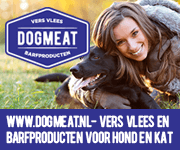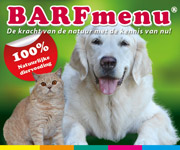Hoi, een tijdje geleden heb ik Mogens Eliasen een email gestuurd met de vraag waarom puppies gevoerd moeten worden met zoveel meer bot als de volwassen hond (ongeveer 2 maal zoveel en misschien zelfs 3 maal zoveel want dan volgens mijn calculatie op 45% bot zou neerkomen)
en hier is het antwoord van Mogens:
I think the confusion comes partially from mixing up "bones" and "bone meal", and maybe I did not explain that well enough. It is important to not overinterpret numbers. The thing is that I do NOT want you to "just take some numbers" and make them into religion... Dogs and puppies are individual and there is no standard numbers that fit all. You have to experiment with it so you can find your own standards, within an overall frame that makes sense. My recommendations are not to be taken that strictly that you can just copy numbers and believe you are doing OK....every puppy and dog has different needs.
As I hope I have explained throught the book, even the "fundamental recipe" of 1/3, 1/3, 1/3 cannot and should not be taken as a rigid dogma for what you should feed. That's why I hate to publish it as an "oracle answer" without also being able to give a full explanation of all the limitations that are associated with it - such as the fact that dogs really do not need vegetables at all! Now, I recommend adding up to 33% vegetables because I have seen so many positive effects of this, and never any negative ones. But I also know of dogs that do thrive OK on no vegetables at all, at least for shorter periods of time - most likely because they get an extremely varied diet that comes very close to representing a complete prey animal... So, my recommending up to one 1/3 vegetables in the diet cannot and should not be taken as a claim that dogs need that much vegetable in their diet... It is an oversimplification that does not give justice to the truth, but only triggers completely unnecessay disputes that have no purpose because they are based on false assumptions about the accuracy of the numbers..
The bone meal supplement to the puppy meals is meant to "cover the base" of the puppy's need for bone. I know from experience that those 10% added to the morning and noon meals will do. You don't need much more - and what you need will come naturally from the evening meal.
But that does not mean that the puppy could not handle more! And it does not mean that it could not thrive on more!
Puppies of bigger breeds should by no means grow too fast. This would call for adding more bone and vegetables - because that will reduce the amount of protein and thus reduce the growth rate....
There is also a good value in occassionally feeding a lot of bone - simply for the sake of variation and for preventing problems with the anal glands.
I hope you noticed that I said "maybe 3 times as much". I know that other people (who are trying to follow Ian Billinghurst's recommendations) feeding up to 45-50% bone in the meals - and some of them get good results. Others have problems. Personally, I feel this is overkill - and I think people should have very good reasons for going to that extreme - but I will not argue with those who have had good experiences with it....
With "twice as much" bone in the diet as for adult dogs, you are not pushing limits, but you are making sure that the puppy gets enough bone - and you are also reducing the protein contents slightly, thus contributing to prevent HD for the bigger breeds.
However, my standard AVERAGE recommendation of bone for an adult dog is about half of a third of the diet - which becomes some 15-20%. This is - again - more than what is absolutely needed, as discusssed on several occassions in the book. I know many cases of dogs getting no more than 5-10% bone in their diet - and they are doing fine. But I know of others that are getting that little - and they are not doing quite so "fine". "Minimum required" and "maximum allowed" and "recommended" are not the same - and nobody really knows where the extremes are - except that it is a fact that those limits will vary with a whole bunch of parameters we don't know very much about, at best...
Your 45% is too high and not represending what I recommend. Because I recommend an adult dog to have some 15% bone does not mean that this is what it needs. That number is less... When I say that a puppy needs about twice as much bone as an adult dog, you cannot take the 15% as base for that calculation - that would be equivalent to saying that twice as much as one apple is two oranges.
I know - this is confusing, because you like to have one number that represents what you should feed. And I cannot give you any such one number without being dishonest and leading you into wrong conclusions - that one number does not exist in any honest science. Any number presented by an honest scientist is not accurate until you know how inaccurate it is!
So, "recommended" is not a number, but a range. I thought I made it clear in the book that you have to be "sloppy" or "generous" with the math and not take it too darn seriously when it comes to accuracy of the details. This is definitely true here - it is the logarithm that counts, not the primary numbers.
You can make the range wider or you can make it narrower if you want to take into account some other factors that also influence this, such as fear of HD for a bigger breed, or an individual problem with lose stools or firm stools, or whatever other problem might cause you to reconsider those numbers. You simply have to make your own informed decisions. There is no way for anybody to provide a meaningful standard that covers all possible variations of problems that influence this.
This is why I do not want to give you any specific number for exactly how much bone is supposed to be in the puppy's diet. I plain simply do not believe that anybody has enough knowledge to provide such a number - and if they thought they did, then I will dispute exactly that, based on the math principles I have tried to explain.
You will notice too that there are no numbers given in the examples of specific diets. That is for this very same reason! If you try to specify numbers, you will be guilty of making mistakes by overinterpreting details that don't matter in the perspective of the overall complexity of the matter and the individual needs.
Please let me know if this clarifies things.
Cheers,
Mogens Eliasen
http://k9joy.com/RauweVoedingVoorHonden ... ?camp=5_em (Dutch)
or
http://k9joy.com/RawFoodForDogs/index.php?camp=5_em (English)






